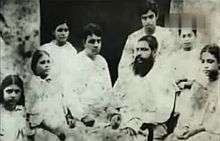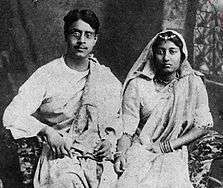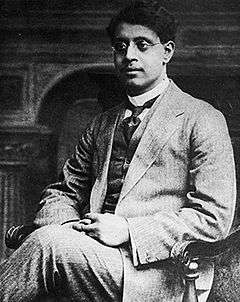Sukumar Ray
| Sukumar Ray | |
|---|---|
|
A well-known image of Sukumar Ray | |
| Born |
30 October 1887 Calcutta, British India |
| Died |
10 September 1923 (aged 35) Residence, Garpar in North Calcutta, British India |
| Language | Bengali |
| Nationality | British Indian |
| Ethnicity | Bengali |
| Period | Bengal Renaissance |
| Genre | literary nonsense |
| Notable works | Abol Tabol, Pagla Dashu, HaJaBaRaLa, |
| Spouse | Suprabha Devi |
| Children | Satyajit Ray (son) |
| Relatives | Upendrakishore Ray (father) and Bidhumukhi (mother) |
Sukumar Ray (Bengali: সুকুমার রায়; ![]() Sukumār Rāẏ ) (30 October 1887 – 10 September 1923)[1] was an Indian Bengali humorous poet, story writer and playwright who mainly wrote for children. His works such as the collection of poems "Aboltabol" (Bengali: আবোলতাবোল)("Gibberish"), novella "HaJaBaRaLa" (Bengali: হযবরল), short story collection "Pagla Dashu" (Bengali: পাগলা দাশু; "Crazy Dashu") and play "Chalachittachanchari" (Bengali: চলচিত্তচঞ্চরী) are considered equal in stature to Alice in Wonderland. More than 80 years after his death, Ray remains one of the most popular of children's writers in both West Bengal and Bangladesh.
Sukumār Rāẏ ) (30 October 1887 – 10 September 1923)[1] was an Indian Bengali humorous poet, story writer and playwright who mainly wrote for children. His works such as the collection of poems "Aboltabol" (Bengali: আবোলতাবোল)("Gibberish"), novella "HaJaBaRaLa" (Bengali: হযবরল), short story collection "Pagla Dashu" (Bengali: পাগলা দাশু; "Crazy Dashu") and play "Chalachittachanchari" (Bengali: চলচিত্তচঞ্চরী) are considered equal in stature to Alice in Wonderland. More than 80 years after his death, Ray remains one of the most popular of children's writers in both West Bengal and Bangladesh.
Sukumar Ray was the son of children's story writer Upendrakishore Ray (Ray Chowdhury), the father of Indian filmmaker Satyajit Ray and grandfather of Bengali filmmaker Sandip Ray. Sukumar Ray was also known as the convenor of "Monday Club" (Bengali: মণ্ডা ক্লাব), a weekly gathering of like-minded people at the Ray residence, where the members were free to express their opinions about the world at large. A number of poems were penned by Sukumar Ray in relation to the matters concerning "Monday Club", primarily soliciting attendance, announcing important meetings etc.
Life


Ray was born in a Brahmo family in Calcutta, India on 30 October 1887. Born in the era which can be called the pinnacle of the Bengal Renaissance, he grew up in an environment that fostered his literary talents. His father was a writer of stories and popular science; painter and illustrator; musician and composer of songs; a technologist and hobbyist astronomer. Upendrakishore was also a close friend of Rabindranath Tagore, who directly influenced Sukumar. Among other family friends were Jagadish Chandra Bose and Prafulla Chandra Roy. Upendrakishore studied the technology of blockmaking, conducted experiments, and set up a business of making blocks. The firm M/s U. Ray & Sons, where Sukumar and his younger brother Subinay were involved. His sister, Shukhalata Rao, became a social worker and children's book author.[2] Like his father, Ray also was a very good friend of Rabindranath Tagore.
In 1906, Ray graduated with honours in physics and chemistry from the Presidency College, then affiliated with the University of Calcutta. Before that he attended City College School, Surya Sen Street along with his classmate, famous funny character "Pagla Dashu" appeared in several of his penned story. He was trained in photography and printing technology in England at the School of Photo-Engraving and Lithography, London,[3] and was a pioneer of photography and lithography in India. While in England, he also delivered lectures about the songs of Rabindranath before Tagore won the Nobel Prize. Meanwhile, Sukumar had also drawn acclaim as an illustrator. As a technologist, he also developed new methods of halftone blockmaking, and technical articles about this were published in journals in England. The Penrose Annual published two articles by Ray. While in the United Kingdom he joined the Royal Photographic Society in 1912 and remained a member until his death, gaining his Fellowship in 1922.[4]
Upendrakishore started a publishing firm, U. Ray and Sons, which Sukumar and Subinay helped to run. While Sukumar went to England to learn printing technology, Upendrakishore purchased land, constructed a building, and set up a printing press with facilities for high-quality halftone colour blockmaking and printing. He also launched the children's magazine, "Sandesh".[1] Very soon after Sukumar's return from England, Upendrakishore died, and Sukumar ran the printing and publishing businesses and the Sandesh for about eight years. His younger brother Subinoy helped him, and many relatives pitched in writing for "Sandesh".
Sukumar Ray was also a leader of the reformist wing in the Brahmo Samaj. Sukumar Ray wrote a long poem "Atiter Katha" (Bengali: অতীতের কথা), which was a popular presentation of the history of the Brahmo Samaj—it was published as a small booklet to introduce the rationale of the Brahmo Samaj to children. Sukumar also campaigned to bring in Rabindranath Tagore, the most famous Brahmo of his time, as a leader of the Samaj.
Death
Sukumar Ray died on 10 September 1923 at his Garpar residence in Kolkata[5] of severe infectious fever, leishmaniasis, for which there was no cure at the time. He left behind his widow and their only child, Satyajit, who was only two years old at that time. Satyajit Ray would later shoot a documentary on Sukumar Ray in 1987, 5 years before his own death.
Works
| Bengali Wikisource has original text related to this article: |
- Abol tabol (Gibberish)
- Pagla Dashu (Crazy Dashu)[6]
- Khai-Khai (Eat-Eat)
- Heshoram Hushiyarer Diary (The diary of Heshoram Hushiyar) (early science fiction parody)[7]
- HaJaBaRaLa (Mumbo-Jumbo)
- Jhalapala O Onanyo Natok (Cacophony and Other Plays)
- Lakkhaner Shoktishel (The Weapon of Lakkhan)
- Chalachittachanchari
- Shabdakalpadrum
- Bohurupi
- Bhasar Atyachar (Torture of Language 1915)
Bibliography
English Editions of Sukumar Ray, in chronological order. Each edition here has its distinct merits.(citation needed)
Nonsense Rhymes. Translated by Satyajit Ray. Calcutta: Writer's Workshop, 1970.
- This volume by the author's son is the slimmest and is difficult to find.
The Select Nonsense of Sukumar Ray. Translated by Sukanta Chaudhuri. New Delhi: OUP, 1987.
- The standard edition for many years.
Abol Tabol: The Nonsense World of Sukumar Ray. Translated by Sampurna Chattarji. New Delhi: Puffin, 2004.
- This edition, the most complete, also has works from Khapchhada, Bohurupee, Other Stories, Haw-Jaw-Baw-Raw-Law, Khai-Khai, and Pagla Dashu.
The Tenth Rasa: An Anthology of Indian Nonsense, edited by Michael Heyman, with Sumanyu Satpathy and Anushka Ravishankar. New Delhi: Penguin, 2007.
- This volume includes, amongst other Indian nonsense texts, quite a few Ray translations by Chattarji, including some that are not in her solo edition of Abol Tabol.
References
- 1 2 Ray; Sukumar (tr. Chatterjee; Sampurna). Wordygurdyboom!. Penguin Books India. pp. 177–. ISBN 978-0-14-333078-3. Retrieved 3 October 2012.
- ↑ Sarker, Sushanta (2012). "Rao, Shukhalata". In Islam, Sirajul; Jamal, Ahmed A. Banglapedia: National Encyclopedia of Bangladesh (Second ed.). Asiatic Society of Bangladesh.
- ↑ "Sukumar Ray |". .open.ac.uk. Retrieved 3 October 2012.
- ↑ Correspondence with Dr Michael Pritchard, Director-General, of The Royal Photographic Society, 1 December 2013.
- ↑ "LIfe of Sukumar Ray". Freehostia.
- ↑ Amaresh Datta (1987). Encyclopaedia of Indian Literature: A-Devo. Sahitya Akademi. pp. 694–. ISBN 978-81-260-1803-1. Retrieved 3 October 2012.
- ↑ Early Bengali science fiction, Amardeep Singh, lehigh.edu
External links
- Sukumar Ray Kobita
- Complete Sukumar Ray
- "Drighangchu" by Sukumar Ray translation of short story in The Cafe Irreal
| Wikimedia Commons has media related to Sukumar Ray. |
